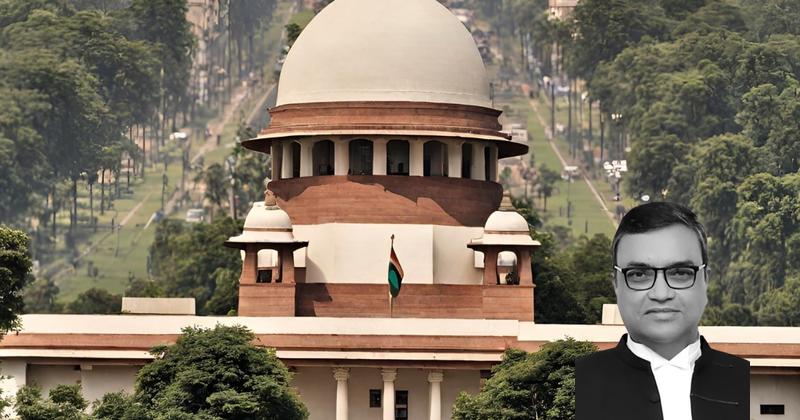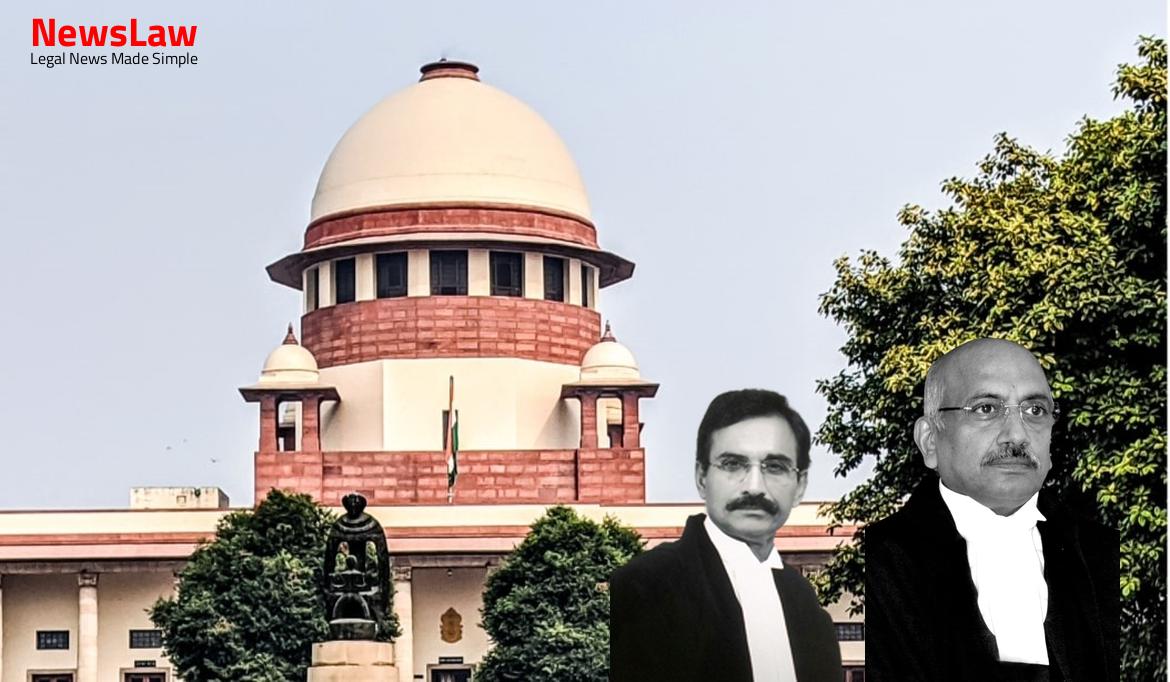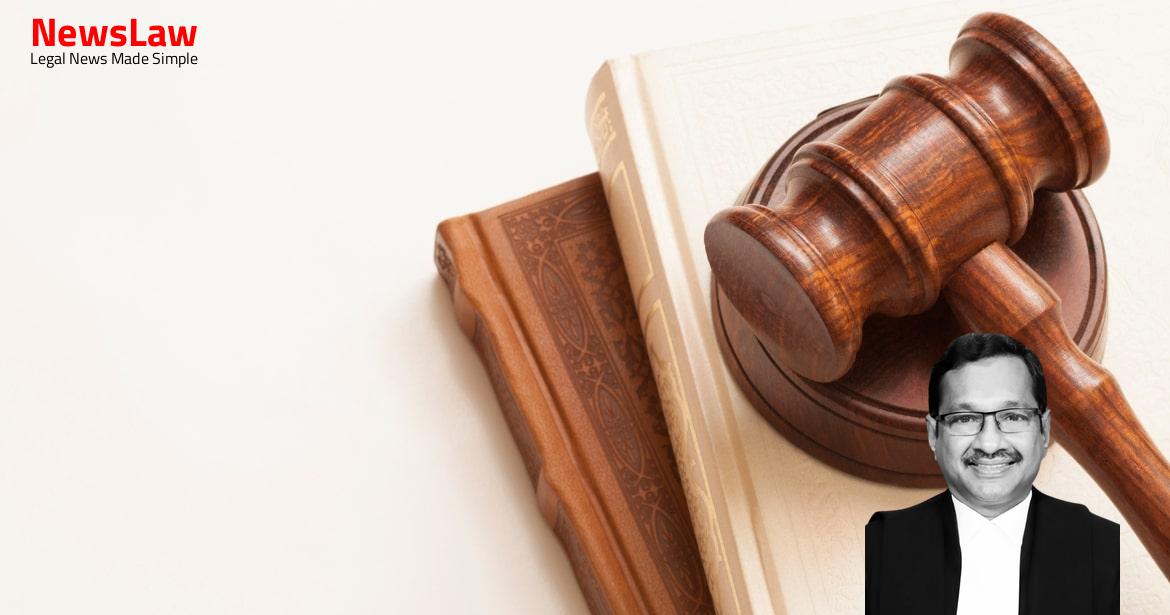The impugned judgment by the High Court of Judicature at Madras affirms the conviction of the appellant – Perumal Raja @ Perumal for murder of Rajini @ Rajinikanth under Section 302 of the Indian Penal Code, 1860 and Section 201 of the IPC, by the Principal Sessions Judge, Puducherry in SC No 22 of 2014, in the charge sheet arising from the First Information Report No 80 of 2008 registered on 24.04.2008 in Police Station Odiansalai, District – Puducherry.
Also Read: https://newslaw.in/supreme-court/analysis-of-set-off-in-insolvency-proceedings/
The prosecution case in brief is as follows: (i) On 20.04.2008, Rajaram, who was settled in France, returned to Puducherry as his son Rajini @ Rajinikanth, who was living in India, had gone missing. (v) The appellant – Perumal Raja @ Perumal, son of Krishnamurthy (husband of the sister of Rajaram), was detained and taken into custody during the course of investigation in FIR No 204 of 2008 for murder of Rajaram.
(ix) Later on, the appellant – Perumal Raja @ Perumal, and other co-accused, decided to remove the dead body of Rajini @ Rajinikanth from the sump tank as they had learnt that Rajaram was returning to India as his son Rajini @ Rajinikanth was missing. (xiv)
The skull recovered from the canal/river and the lower part of the jaw recovered from the sump tank were sent for superimposition test to ascertain whether they belong to the deceased Rajini @ Rajinikanth. This includes Arumugam (PW-20), the grandfather of the deceased Rajini @ Rajinikanth, who had filed the ‘missing man’ complaint for Rajini @ Rajinikanth, vide Diary No 80 of 2008.
Reliance can be also placed on the documentary evidence to establish that the property in question in the name of Rajaram was dealt with by Porkilai (PW-4), mother of the appellant – Perumal Raja @ Perumal. …
took xxx, Iron box, Home theatre, xxx, xxx, rental documents of my uncle’s house at Chittankudi, Hero Honda CD Dawn motorcycle, RC book and key, Rajini’s passport book, Rajini’s passport size photo, birth registration of grandmother, family ration card of uncle and the copy of documents written in English, bunch of keys of the house and my uncle Ranjith’s notebook, xxx xxx xxx, took Hero Honda CD Dawn motorbike of my uncle Rajaram…..one bag was put by Mohan xxx xxx xxx the house of Mohan nearby to the Tollgate of Ariyankuppam, kept 2 bags in Mohan’s house…… I, immediately, went to N (name withheld) house and gave him document, ration card, bunch of keys, Rajini’s passport, by keeping them in Ranjith notebook and stated to keep them safe…… I took the already kept 3 sack bags, rope, curry knife, showed the sump tank to xxx. …via Chinnavaikal Street and Gandhi Street, turned on the left side of the street, in front of small clock tower, via Varnarapettai Billu Shop, on the centre of the bridge of Railway Crossing on the left side, threw the two bags, containing the decomposed body of Rajini, on the right side threw the sack bag, containing knife and xxx…… Also, I gave statement that if I was taken, I would identify the Chinnavaikal street, which is the place of occurrence, my maternal uncle’s house which is in the same street..the place where I had left the motor cycle of my (nc) and the place where I had put the body of Rajini… ” 10. On the same day, stolen items including, the motorcycle and ignition key of motorcycle, original registration book, insurance certificate of the motorcycle, iron box, home theatre and speaker box belonging to the deceased were recovered, as recorded seizure vide mahazar (Exhibits P-44, P-45, P-46 and P-47). The recovery was photographed by Subburayan (PW-25), police photographer vide photographs marked Exhibit P-18 and duly witnessed by public witness Devadass (PW-21). Pushparani (PW-29), Scientific Assistant Grade II, Anthropology Division, Forensic Sciences Department, Chennai had enclosed the computer laser printouts taken by her at the time of examination to establish and prove that the photographs of deceased – Rajini @
Also Read: https://newslaw.in/case-type/civil/inherent-jurisdiction-and-invalid-decree-a-case-summary/
Rajinikanth match with the mandible and the skull (Exhibits P-26 to P-28). Diwakar (PW-24), Senior Medical Officer, Department of Forensic Medicine, Government General Hospital, Puducherry has also deposed that the deceased could be between 25-30 years of age and probable death could have occurred six months prior to the autopsy. Diwakar (PW-24), Senior Medical Officer, Department of Forensic Medicine, Government General Hospital, Puducherry has also stated that the lower jaw and the left lower first premolar tooth were preserved by him from the skeleton remains for onward transmission to Central Forensic Science Laboratory, Hyderabad, for necessary photo superimposition and DNA test through the Judicial Magistrate-II, Puducherry.
Diwakar (PW-24), Senior Medical Officer, Department of Forensic Medicine, Government General Hospital, Puducherry, in his deposition, while referring to Exhibit P-17 dated 19.05.2008, has referred to the lower jaw (mandible) and the left lower first premolar tooth, to send the said body parts to the Central Forensic Science Laboratory at Hyderabad. Diwakar (PW-24), Senior Medical Officer, Department of Forensic Medicine, Government General Hospital, Puducherry had issued bone-case certificate (Exhibit P-17) on 19.05.2008. Diwakar (PW-24), Senior Medical Officer, Department of Forensic Medicine, Government General Hospital, Puducherry has clarified that while he did not mention the lower jaw in the post mortem 26.04.2008 (Exhibit P-16), he had mentioned that the lower jaw was preserved in the bone-case certificate (Exhibit P-17) dated 19.05.2008.
Section 26 of the Evidence Act provides that no confession made by any person whilst he is in the custody of a police officer shall be proved against such person, unless it is made in the immediate presence of a Magistrate. It makes that part of the statement which distinctly leads to discovery of a fact in consequence of the information received from a person accused of an offence, to the extent it distinctly relates to the fact thereby discovered, admissible in evidence against the accused. The discovery of the fact resulting in recovery of a physical object knowledge or mental awareness of the person accused of the offence as to the existence of the physical object at the particular place. State of Maharashtra, elucidating on Section 27 of the Evidence Act, it has been held that the first condition imposed and necessary for bringing the section into operation is the discovery of a fact which should be a relevant fact in consequence of information received from a person accused of an offence. Section 27 of the Evidence Act is frequently used by the police, and the courts must be vigilant about its application to ensure credibility of evidence, as the provision is vulnerable to abuse.
State of Madhya Pradesh, which held that formal accusation and formal police custody are essential pre-requisites under Section 27 of the Evidence Act. The reason is that the expression “accused person” in Section 24 and the expression “a person accused of any offence” in Sections 26 and 27 have the same connotation, and describe the person against whom evidence is sought to be led in a criminal proceeding. The confession includes not only the admission of the offence but all other admissions of incriminating facts related to the offence, except to the extent that the ban is lifted by Section 27 of the Evidence Act. Thus, in our considered view the correct interpretation would be that as soon as an accused or suspected person comes into the hands of a police officer, he is no longer at liberty and is under a check, and is, therefore, in “custody” within the meaning of Sections 25 to 27 of the Evidence Act.
State of Uttar Pradesh, has held that the expression “custody” in Section 27 of the Evidence Act does not mean formal custody, but includes any kind of surveillance, restriction or restraint by the police. However, evidentiary value to be attached on evidence produced before the court in terms of Section 27 of the Evidence Act cannot be codified or put in a straightjacket formula. This would, the Court held, reveal that the dead body was concealed by the accused unless there is material and evidence to show that somebody else had concealed it and this fact came to the knowledge of the accused either because he had seen that person concealing the dead body or was told by someone else that the dead body was concealed at the said location. Apart from Section 27 of the Evidence Act, Section 8 of the said Act would be also attracted insofar as the prosecution witnesses, namely, the investigating officers, Chinta Kodanda Rao (PW-30), Inspector of Police, PS Grand Bazaar and T.
The motorcycle owned by Rajaram, which the deceased Rajini @ Rajinikanth used to use, was missing. (vi) On the basis of the disclosure statement made by the appellant – Perumal Raja @ Perumal on 25.04.2008 (Exhibit P-37) – (a) two nylon sack bags were recovered containing decomposed human body parts; and (b) human bones were also recovered from the sump tank in property bearing No.13, Chinna Vaikkal street, Puducherry. The deceased Rajini @
Rajinikanth was of 30 years in age and he had been missing for about six months. State of Maharashtra, this Court referred to Hanumant v. Thus, a distinction has to be drawn between incomplete chain of circumstances and a circumstance after a chain is complete and the defence or explanation given by the accused is found to be false, in which event the said falsehood is added to reinforce the conclusion of the court.
State of Bihar has laid down the following principle regarding circumstantial evidence and the failure of accused to adduce any explanation: “It is true that in a case of circumstantial evidence not only should the various links in the chain of evidence be clearly established, but the completed chain must be such as to rule out a reasonable likelihood of the innocence of the accused.
In this circumstance, the failure of the appellant – Perumal Raja @ Perumal to present evidence on his behalf or to offer any cogent explanation regarding the recovery of the dead body by virtue of his special knowledge must lead to a reasonable adverse inference, by application of the principle under Section 106 of the Evidence Act, thus forming an additional link in the chain of circumstances. Rajinikanth had been murdered and his body was first dumped in the sump tank and after some months, it was retrieved, cut into two parts, put in sack bags, and thrown in the river/canal.
Case Title: PERUMAL RAJA @ PERUMAL Vs. STATE REP. BY THE INSPECTOR OF POLICE (2024 INSC 13)
Case Number: Crl.A. No.-000248-000248 / 2024



